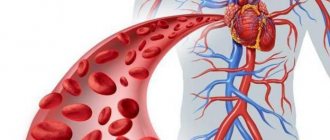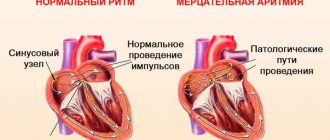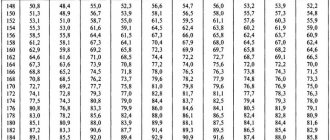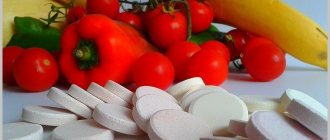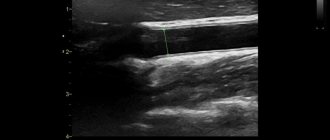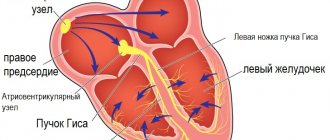Under the influence of significant physical activity, a person’s skeletal muscles change, become more massive, and the heart as a muscular organ also changes, because it must produce a larger volume of blood at a higher speed, providing all cells with adequate nutrition and gas exchange. Professional and serious amateur sports with huge regular loads have a particularly pronounced effect on the cardiovascular system.
How the heart reacts to sports stress
At maximum athletic activity, the heart contracts more than two hundred times, pumping more than 30 liters of blood per minute. Trying to ease the colossal cardiac work, the body distributes blood more efficiently, reducing the resistance of the vascular walls, dilating the vessels of skeletal muscles and opening additional collateral vessels, which were previously in a collapsed state. However, even with such a significant compensatory decrease in blood flow, the heart works on the verge of beyond its capabilities.
Under the influence of loads, the heart changes its configuration - it is remodeled to ensure the viability of all organs under intense load. Morphological - biological changes correct the electrophysiology of the myocardium, that is, the emergence of an electrical potential for contraction of the heart chambers and their relaxation. In four out of ten professional athletes, the ECG recording, reflecting the electrophysiological characteristics of the heart, differs from the normal electrocardiogram in the height and depth of the waves.
Over time, but before that, at least two or three years of regular sports activities will pass, the heart will adapt to constant loads that are excessive for the normal body, so that the skeletal muscles are able to develop strength that is inaccessible to an untrained person.
Types of physical activity
Depending on the intensity, experts identify moderate-intensity exercises:
- walking at an average pace (at a speed of up to 5 km/h);
- aerobics or free swimming in the pool;
- bicycle up to 10 km/h;
- tennis or other team games;
- work in the garden (increased load).
These types of exercises are considered vigorous:
- jogging > 6 km/h;
- swimming in circles for a while;
- aerobic dancing;
- bicycle > 10 km/h;
- jumping rope;
- hiking up the mountain with a heavy backpack.
When comparing physical activity of varying intensity, one minute of vigorous exercise is equivalent to two minutes of moderate intensity exercise. To strengthen the cardiovascular system and the body as a whole, it is better to train at a calm pace 3-4 times a week for 30-40 minutes. Swimming in a pool or pond with clean water in the summer is an excellent alternative to walking. To strengthen the heart, physical activity should be regular and not cause discomfort (pain in the heart, joints or severe shortness of breath).
The “correct” heart of an athlete
The heart of an athlete is referred to as “athletic.” There is a distinction between a heart adapted to high loads, which adequately ensures the functioning of the body, and a pathological sports heart formed by excessive loads for the myocardium. There is an increase in the thickness of the wall - the mass of the myocardium, the cavities of the ventricles and atria increase, but this happens in different ways.
The physiological or “correct” athletic heart itself is better nourished due to the expansion of its own coronary capillary network and increased formation of new vessels. The large thickness of the walls allows them to effectively and intensely contract and relax, due to the high elasticity and significant energy reserves in the cardiomyocyte - the myocardial cell. The cavities of the atria and ventricles enlarge to receive and subsequently release a larger volume of blood during athletic activity.
Different sports change the configuration of the heart in their own way, it all depends on the pace at which the athlete moves. All athletes have increased thickness of the ventricular myocardium, but in all dynamic and “running” sports, including cycling and swimming, the volume of the internal cavity of the ventricles increases. The ventricles are uniformly large - thick walls correspond to a large internal volume, which is necessary for increased and enhanced blood release.
During “standing” sports, for example, wrestling and weightlifting, blood pressure increases excessively, and with a normal size of the ventricular cavity, its wall is thickened, which is why visually the ventricle looks unevenly enlarged: the wall is thick, and the internal cavity is small.
In rowing sports there is an alternation of dynamic and static loads, therefore the changes in the myocardium are average between the two main options. Racial characteristics also affect the configuration of the correct athletic heart; the maximum severity of the configuration is observed in athletes of the Negroid race, so they are the fastest and most resilient.
At rest, the athlete’s heart works in an economical mode with a small number of contractions - 40-60 per minute, its need for oxygen decreases, the relaxation phase (diastole) exceeds the contraction phase (systole), the blood flow speed drops - blood pressure is reduced. This is a kind of suspended animation of the heart muscle, the purpose of which is complete rest, so that at the decisive moment you can devote yourself entirely to work of unprecedented intensity.
Pathological athlete's heart
In the United States, they keep a special register where the death of an athlete is celebrated every third day, and mostly football players die - a kind of American football is “densely implicated” in rugby. We do not have such records, but all death cases are widely covered by the press; Russian athletes clearly die much less often. The cause of their death is, as a rule, a pathological sports heart, which is formed by unsystematic extreme loads, doping, training against the background of banal infections and, of course, genetic characteristics.
The mass and thickness of the walls of the heart in this situation are also greater than normal, but due to the lag in the growth of coronary capillaries from the increase in the myocardium itself, its nutrition is disrupted. The muscle is less elastic, so contractility suffers and, therefore, maximum relaxation at rest is impossible. The volume of not only the ventricles that eject blood increases, but also the volume of the atria that receive blood. The volume of the heart is increased, but much more than it should be - more than 1200 cubic centimeters.
Also, the heart rarely contracts, bradycardia occurs. It can be more pronounced, that is, less than 40 contractions per minute, especially at night, which leads to severe oxygen starvation of the brain. With a normal athletic heart, the athlete does not feel a slow heartbeat in any way; when bradycardia is accompanied by clinical symptoms, then this is no longer a normal adaptation of the heart to high loads, but a pathological condition. Decrease in blood pressure below 100/60 mmHg. in such a situation, it is also not an adaptation of the body, but a reaction to painful changes.
What happens in the body during ARVI
Fever, runny nose, cough are signs that pathogenic microbes have entered the body. “Elevated body temperature means that microorganisms that cause respiratory diseases have entered the blood and began to circulate throughout the body, choosing where to settle,” comments Natalya Polenova. — A rise in body temperature leads to increased heart rate and respiratory movements, and loss of fluid from the surface of the body and mucous membranes. Symptoms of intoxication develop, which any additional load only aggravates. We are no longer talking about any muscle growth, an anabolic process (which requires additional energy): the body devotes all its strength to fighting the infection.”
But despite this, some fitness fans still strive to train in this state.
Such different hypertrophies
The manifestations of a healthy sports heart and a pathological one are similar, but healthy cardiac hyperfunction is intermittent, characterized by a decrease during the period outside training and competition, while pathological hyperfunction is constant and becomes irreversible over time. The pathological heart is always at work because it must always overcome its hidden weakness. All this is referred to as a violation of the heart’s adaptation to stress - maladaptation, which can lead to sudden death.
The athlete does not feel the transition from a physiological sports heart to a pathological one, he simply becomes less efficient, gets tired easily and hardly recovers during rest, and attacks of dizziness are possible during training. During the examination, thickening of the heart muscle is revealed with insufficient relaxation in the diastole phase, this already indicates a disease - initial asymptomatic cardiomyopathy.
Not only the contractile function suffers, but also the formation of electrical potential for the implementation of contractions - rhythm is disrupted. Heart rhythm disturbances are manifested by untimely beats, irregular pulses, or simply loss of consciousness. When you rest from training, rhythm disturbances disappear, but changes in the heart muscle remain. Gradually, the heart muscle is replaced by scars, turning the ventricles of the heart into weakly contractible scar sacs, which “drive” blood with great difficulty, and heart failure progresses.
Myocardial hypertrophy, as a heart disease, and pathological athlete's heart have similarities, but in heart disease, hypertrophy is needed to compensate for an anatomical or functional defect, for example, valvular disease. With an athletic heart, hypertrophy is necessary for the implementation of muscle efforts, that is, it does not have an underlying defect. However, with any pathological hypertrophy, cellular metabolism is first disrupted, then the structure of the myocardium changes with the formation of scars, and finally, cardiac function suffers.
Can I go for a light workout?
Unfortunately no. “When ARVI and influenza manifest themselves, any training is prohibited. Even stretching, yoga or roller flexing can backfire. Wait until you have fully recovered and your doctor gives you permission to start training. Take care of your health, it is priceless,” warns an employee of one of the medical centers.
Do you feel like you're getting sick? Give up sports. “If you begin to experience symptoms of illness, I would advise you to refrain from any physical activity and devote your free time to a walk in the park or recreational activities,” says the group training leader. — Don’t worry, most of the indicators will remain at the same level for a certain amount of time. Muscles lose their strength after 2 weeks of lack of targeted training, endurance decreases after 3 days, but it will not be difficult to restore the level already achieved. And with a balanced diet and a healthy regimen, your figure will practically not suffer due to a temporary decrease or lack of exercise.”
Focus on restoring your health: rest, drink plenty of warm fluids, ventilate the room more often, follow your doctor's recommendations. You’ll get back to fitness later.
It is very important to eat a balanced diet for faster recovery. “To fight infection, it is necessary to build immunity, antibodies, and therefore eat protein. It is clear that during intoxication, appetite is reduced, and volitional efforts will have to be made. Let me remind you that protein is not only fried steak, but also yogurt, cottage cheese, omelet, and just egg white. Any of these products, in combination with competent drug treatment, sufficient water consumption and a gentle regimen, will help quickly defeat the disease,” notes Natalya Polenova.
When big sport is prohibited
Changes in the myocardium under high physical loads are inevitable; normal hyperfunction mobilizes all the physiological resources of the heart; in the presence of some anatomical defects of the heart and blood vessels, the loads on the myocardium are not simply summed up, but increase exponentially. With undetected heart disease or arterial hypertension, cardiac hyperfunction is continuous, there is no rest for the heart, as happens with a healthy athletic heart, and cardiomyopathy develops very quickly against the background of exacerbation of a chronic disease.
Exacerbations of chronic heart diseases that are not diagnosed in time are not classified as a pathological sports heart, because they were not formed by sport, but by human nature, and sport only revealed and aggravated them.
People suffering from valvular and other congenital defects and diseases of the heart and blood vessels, heart rhythm disturbances, and heart configuration disorders are completely justifiably not allowed into elite sports, because such a heart is not able to bear excessive loads and may stop.
Diseases of the heart and blood vessels seriously threaten human health and even life. Periodic medical examinations are designed to detect the disease in time so that you do not have to deal with the consequences belatedly. Consulting a cardiologist makes it possible to keep your health under control. To make an appointment with a cardiologist, call +7 (495) 120-08-07.
What is strictly forbidden to do?
People with cardiovascular problems, and in general all novice athletes, should not force the load. If a person previously sat in an office and moved little, from car to home or from car to work, then going out for a running workout will pose a huge risk for him. He is unlikely to be able to run for long because he will quickly develop a running injury such as plantar fasciitis (inflammation of the ligaments) or inflammation of the Achilles tendon (located near the heel).
Mysteries of Nordic walking: what kind of sport is it and why is it needed?
“Sports” diseases: what diseases are common among professional athletes?
Regular physical activity really helps treat cardiovascular diseases and keep you in good shape. No medicine can dilate your blood vessels for a long time as much as muscle work. And if sport is present in your life, then, most likely, this or that ailment, for example, arterial hypertension, can significantly soften or even go away.
